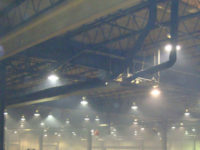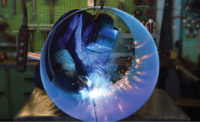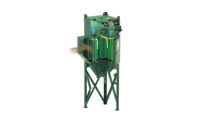An explosion is a serious risk at many manufacturing, processing and metalworking plants, and it can even stem from a dust collection system that’s protected incorrectly. NFPA 68 Standard on Explosion Protection by Deflagration Venting applies to the design, location, installation, maintenance and use of devices and systems that vent combustion gases and pressures resulting from a deflagration within an enclosure in order to minimize structural and mechanical damage.
The standard’s safety objective is to prevent structural failure of the occupied enclosed areas and minimize injury to personnel in areas adjacent to the enclosed space. Whether you vent your dust collector outdoors or indoors, proper design is crucial to deflagration protection.
Outdoor explosion venting
A passive deflagration protection system reacts to an event, while active systems detect and react prior to or during an event. A passive system can control explosions to keep employees safe and minimize equipment damage in the plant. A common, cost-effective passive method is venting; an active system involves more expensive technology and typically requires recertification on a regular schedule.
A well-designed explosion vent opens when the collector’s interior reaches a predetermined pressure, allowing the excess pressure and flame front to exit to a safe area. In the event of a deflagration, explosion venting can prevent the collector from reaching high levels of pressure that would cause the housing to fragment and create projectiles that would cause destruction, thereby reducing the hazards to personnel and facilities. When the dust collector is located outside, it must be designed to vent away from buildings and populated areas.
While explosion venting will usually save the dust collector from being a total loss, the collector can still sustain damage. A thorough inspection of the entire dust collection system should be made paying close attention any damage to bolted components like fans, ductwork or door hardware, housing and tube sheet, and filter integrity. Nonetheless, if personnel remain safe, the explosion venting equipment has done its job.
Indoor flameless venting devices
NFPA 68 allows flameless venting inside buildings when venting outdoors is not feasible or desirable. For example, you may need to locate your dust collector indoors without access to an outside wall or without the ability to vent through the ceiling.
Flameless venting devices allow you to vent an explosion safely indoors without allowing any flame and a minimal pressure front to escape from the collector. Work with the manufacturer of your device to determine the correct safety zone.
Devices that meet this standard are commercially available in various configurations. Although flameless devices for quenching explosions is a viable option to ducted explosion vents, it’s not recommended for toxic dust applications because dust can be released into the room where venting occurs.
Ductwork protection
NFPA requires protection for the ductwork and safety processes upstream of the dust collector. Equip the ducting with a flow-activated isolation valve protecting downstream work areas and processes from the propagation of flame and pressure through the inlet duct when deflagration occurs in a dust collector. The pressure wave will close the valve during deflagration in a dust collector, preventing flame and smoke to pass to areas upstream from the valve.
Active explosion suppression systems
If it’s not feasible to duct an explosion to the outside through a wall or ceiling in your dust collection application, you’ll need an explosion suppression or suppression-isolation system. Suppression methods are covered in NFPA 69: Standard on Explosion Prevention Systems. NFPA 69 extends beyond explosion venting to address the whole dust collection system — inlet and outlet ducting, spark-extinguishing systems and methods for preventing an explosion from traveling back into the building.
Active explosion suppression solutions include:
- Chemical isolation: Designed to react within milliseconds of detecting an explosion, a chemical suppression system can be installed in either inlet and/or outlet ducting. Typical components include explosion pressure detector(s), flame detector and a control panel. This system creates a chemical barrier that suppresses the explosion within the ducting and reduces the propagation of flame.
- Chemical suppression: Whereas chemical isolation is used to detect and suppress explosions within the ducting, chemical suppression protects the dust collector itself. It is often used, together with isolation, when it is not possible to safely vent an explosion or where the dust is harmful or toxic. The system detects an explosion hazard within milliseconds and releases a chemical agent to extinguish the flame before an explosion can occur.
- Fast acting valve: Designed to close within milliseconds of detecting an explosion, the valve installs in either inlet and/or outlet ducting. It creates a mechanical barrier within the ducting that effectively isolates pressure and flame fronts from either direction, preventing them from propagating further through the process.
- High-speed abort gate: The gate is installed in the inlet and/or outlet ducting of a dust collection system and is used to divert possible ignition hazards from entering the collector, preventing a possible explosion from occurring and preventing flame and burning debris from entering the facility through the return air system.
Because combustible dust issues are complex and incidents can be devastating, it’s important to use an experienced independent professional engineer to help you design and install your system. That way you can be certain that your facility complies with NFPA requirements and those of your local fire marshal and insurance carriers. You can view or purchase a copy of Standard 68 and Standard 69 on NFPA’s website.



